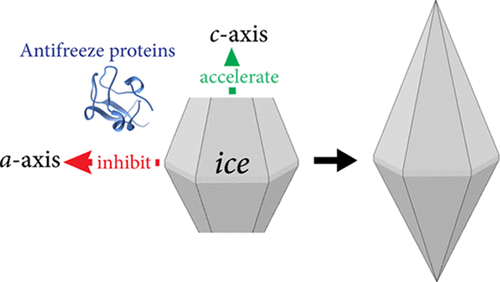当前位置:
X-MOL 学术
›
J. Phys. Chem. B
›
论文详情
Our official English website, www.x-mol.net, welcomes your
feedback! (Note: you will need to create a separate account there.)
Ice Growth Acceleration by Antifreeze Proteins Leads to Higher Thermal Hysteresis Activity
The Journal of Physical Chemistry B ( IF 2.8 ) Pub Date : 2020-11-24 , DOI: 10.1021/acs.jpcb.0c08119 Jinzi Deng 1 , Elana Apfelbaum 1 , Ran Drori 1
The Journal of Physical Chemistry B ( IF 2.8 ) Pub Date : 2020-11-24 , DOI: 10.1021/acs.jpcb.0c08119 Jinzi Deng 1 , Elana Apfelbaum 1 , Ran Drori 1
Affiliation

|
Since some antifreeze proteins and glycoproteins (AF(G)Ps) cannot directly bind to all ice crystal planes, they change ice crystal morphology by minimizing the area of the crystal planes to which they cannot bind until crystal growth is halted. Previous studies found that growth along the c-axis (perpendicular to the basal plane, the crystal plane to which these AF(G)Ps cannot bind) is accelerated by some AF(G)Ps, while growth of other planes is inhibited. The effects of this growth acceleration on crystal morphology and on the thermal hysteresis activity are unknown to date. Understanding these effects will elucidate the mechanism of ice growth inhibition by AF(G)Ps. Using cold stages and an infrared laser, ice growth velocities and crystal morphologies in AF(G)P solutions were measured. Three types of effects on growth velocity were found: concentration-dependent acceleration, concentration-independent acceleration, and concentration-dependent deceleration. Quantitative crystal morphology measurements in AF(G)P solutions demonstrated that the adsorption rate of the proteins to ice plays a major role in determining the morphology of the bipyramidal crystal. These results demonstrate that faster adsorption rates generate bipyramidal crystals with diminished basal surfaces at higher temperatures compared to slower adsorption rates. The acceleration of growth along the c-axis generates crystals with smaller basal surfaces at higher temperatures leading to increased growth inhibition of the entire crystal.
中文翻译:

抗冻蛋白加速冰的生长导致更高的热滞后活性
由于某些抗冻蛋白和糖蛋白(AF(G)Ps)无法直接结合到所有冰晶平面,因此它们通过最小化它们无法结合的晶面面积来改变冰晶形态,直到晶体生长停止为止。先前的研究发现,沿c的增长轴(垂直于基底平面,这些AF(G)Ps无法结合的晶面)被某些AF(G)Ps加速,而其他平面的生长受到抑制。迄今为止尚不清楚这种生长加速对晶体形态和热滞后活性的影响。了解这些影响将阐明AF(G)Ps抑制冰生长的机制。使用冷台和红外激光,对AF(G)P溶液中的冰生长速度和晶体形态进行了测量。发现了三种对生长速度的影响:浓度依赖的加速度,浓度无关的加速度和浓度依赖的减速。AF(G)P溶液中的定量晶体形态测量表明,蛋白质对冰的吸附速率在确定双锥体晶体的形态中起主要作用。这些结果表明,与较低的吸附速率相比,较高的吸附速率会在较高温度下生成双锥晶体,基面减小。随着增长的加速c轴在较高温度下生成具有较小基面的晶体,从而导致整个晶体的生长抑制作用增强。
更新日期:2020-12-10
中文翻译:

抗冻蛋白加速冰的生长导致更高的热滞后活性
由于某些抗冻蛋白和糖蛋白(AF(G)Ps)无法直接结合到所有冰晶平面,因此它们通过最小化它们无法结合的晶面面积来改变冰晶形态,直到晶体生长停止为止。先前的研究发现,沿c的增长轴(垂直于基底平面,这些AF(G)Ps无法结合的晶面)被某些AF(G)Ps加速,而其他平面的生长受到抑制。迄今为止尚不清楚这种生长加速对晶体形态和热滞后活性的影响。了解这些影响将阐明AF(G)Ps抑制冰生长的机制。使用冷台和红外激光,对AF(G)P溶液中的冰生长速度和晶体形态进行了测量。发现了三种对生长速度的影响:浓度依赖的加速度,浓度无关的加速度和浓度依赖的减速。AF(G)P溶液中的定量晶体形态测量表明,蛋白质对冰的吸附速率在确定双锥体晶体的形态中起主要作用。这些结果表明,与较低的吸附速率相比,较高的吸附速率会在较高温度下生成双锥晶体,基面减小。随着增长的加速c轴在较高温度下生成具有较小基面的晶体,从而导致整个晶体的生长抑制作用增强。











































 京公网安备 11010802027423号
京公网安备 11010802027423号